Bright, fresh, and packed with vibrant veggies, this Easy Vegetable Pasta Primavera Recipe is exactly what you want on a weeknight when you crave something satisfying yet light. It’s colorful, creamy, and surprisingly simple to pull together—even on busy evenings.
Jump to:
Why You'll Love This Recipe
What makes this pasta primavera a keeper in my kitchen is how effortlessly it turns a medley of simple vegetables into a silky, flavorful dish. Plus, it’s one of those meals that feel fancy without needing fuss, which means more time eating and less time stressing.
- Vibrant veggie variety: Each bite offers a great mix of textures and fresh flavors that make this dish anything but boring.
- Creamy yet light sauce: The combo of cream, broth, and Parmesan makes a luscious sauce that isn’t too heavy.
- User-friendly approach: Whether you’re a kitchen newbie or a seasoned cook, the steps are straightforward and forgiving.
- Flexible ingredients: You can swap veggies or add your favorite protein without losing the magic.

Ingredients & Why They Work
The combination of fresh vegetables with simple pantry staples is what truly elevates this Easy Vegetable Pasta Primavera Recipe. I always choose crisp, colorful veggies for a balanced visual and flavor punch. Also, having a mix of textures from crunchy broccoli to tender peas keeps things interesting.
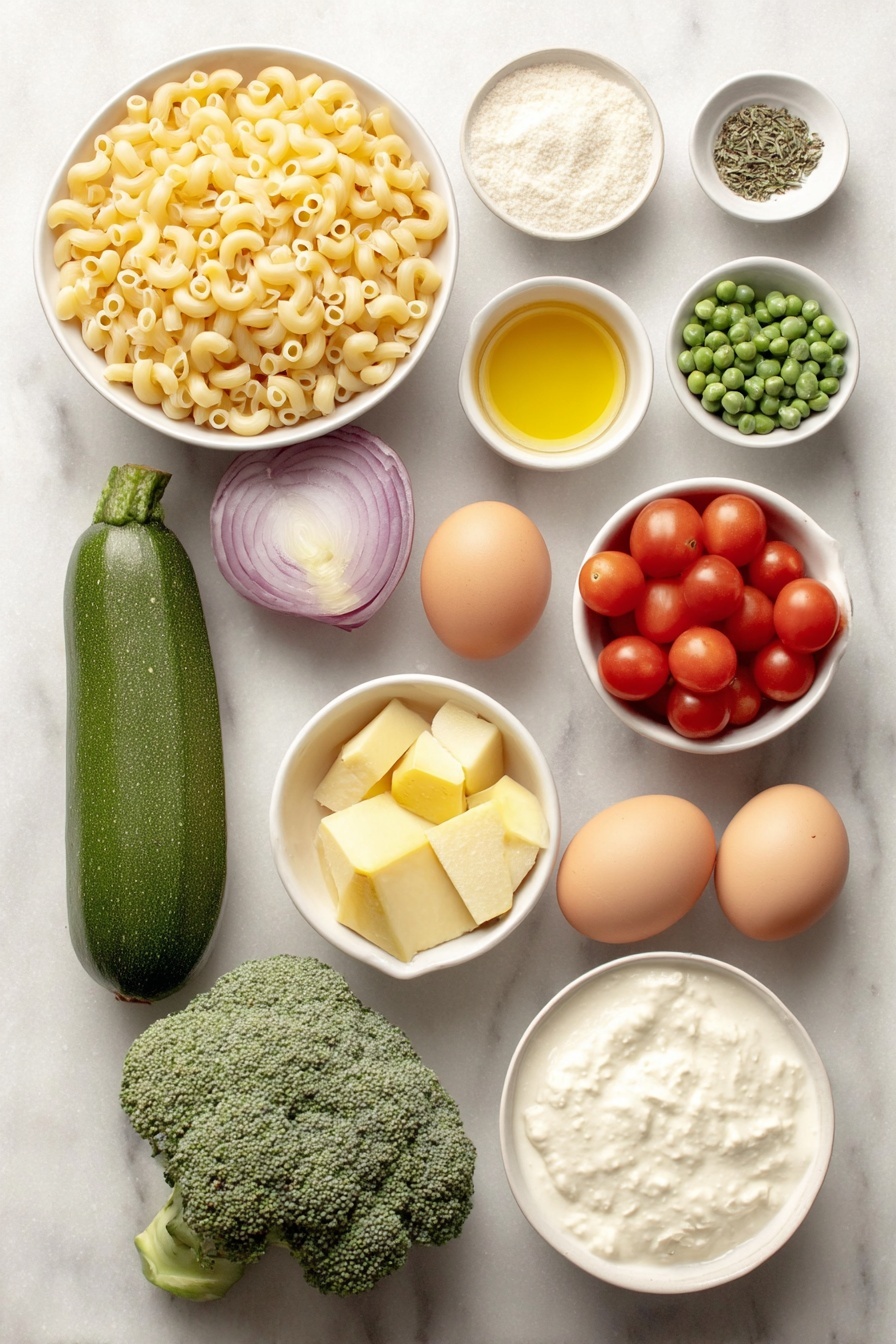
- Cavatappi pasta: Its curly shape traps sauce perfectly, but penne or fusilli work great too.
- Extra virgin olive oil: Adds a fruity richness; divide it to layer flavors through the cooking process.
- Red onion: Gives a mild sweetness and depth without overpowering.
- Broccoli florets: Provide a nice crunch and earthy undertone.
- Yellow squash and zucchini: Both contribute delicate flavors and a light bite.
- Asparagus: Adds a subtle grassy note and vibrant green color.
- Red bell pepper: Sweetness and brightness that contrast well with the cream.
- Cherry tomatoes: Bursting with juice, they add freshness and slight acidity.
- Garlic and red pepper flakes: Essential aromatics for warming up the dish.
- Heavy cream (or evaporated milk): Creates the luscious sauce that ties everything together.
- Chicken broth: Adds savory depth without heaviness.
- Cornstarch: Helps thicken the sauce without lumps or heaviness.
- Herbs (oregano, parsley, thyme): Give complexity and balance the creaminess.
- Lemon juice: Brightens and lifts the entire plate.
- Parmesan cheese: The key to cheesy, savory richness—always freshly grated!
- Frozen petite peas: Sweet pops of color and texture.
- Fresh basil: Finishing herb for a fragrant burst that brings it all home.
Make It Your Way
I love mixing up this Easy Vegetable Pasta Primavera Recipe depending on what’s fresh or what I have on hand. It’s a great base to showcase seasonal vegetables or to accommodate what you like best—make it yours!
- Variation: I sometimes swap out the asparagus for green beans or snap peas for added crunch, and it never disappoints. You can also add grilled chicken or shrimp if you want to boost protein.
- Dietary tweaks: To make it lighter, use evaporated milk instead of cream or swap out pasta for your favorite gluten-free variety.
- Seasonal shifts: In the fall, roasted butternut squash or mushrooms blend beautifully in place of some of the spring veggies.
Step-by-Step: How I Make Easy Vegetable Pasta Primavera Recipe
Step 1: Cook the Pasta Just Right
Start by cooking your pasta in salted boiling water according to the package instructions. I personally test it around 2-3 minutes before the recommended time to ensure it’s al dente—firm to the bite without being crunchy. Don’t forget to reserve half a cup of that pasta water before draining; it’s pure gold for adjusting your sauce later.
Step 2: Sauté Your Vibrant Veggies
Heat 3 tablespoons of olive oil in a large, deep skillet over medium-high heat. Toss in the chopped red onion and broccoli first and sauté for about 3 minutes to start softening without losing their crunch. Then add yellow squash, zucchini, asparagus, red bell pepper, cherry tomatoes, and season lightly with salt and pepper. Give everything a quick 2-minute sauté—remember, we want those veggies tender-crisp, not mushy. Once done, transfer the veggies to a bowl and set aside.
Step 3: Create the Creamy Sauce Base
In the now-empty skillet, add the remaining tablespoon of olive oil over medium heat. Toss in the minced garlic and red pepper flakes and sauté a quick 30 seconds until fragrant. Lower the heat and pour in the heavy cream, stirring gently. Whisk together the chicken broth and cornstarch then slowly add it in along with dried oregano, parsley, thyme, and a pinch more salt. Let the sauce simmer and thicken for about 3 to 5 minutes.
Step 4: Finish with Cheese, Herbs & Lemon
Stir in half a cup of freshly grated Parmesan until it melts into a silky sauce, then add lemon juice, thawed peas, and fresh chopped basil. Warm through—this magic mix brings the dish’s bright, creamy character fully alive.
Step 5: Bring It All Together
Return your sautéed vegetables to the sauce, then gently fold in the pasta. If the sauce feels too thick, add the reserved pasta water a little at a time until you reach the perfect consistency. I often skip adding extra water, but it’s a handy trick if you want a looser sauce. Taste and season with freshly cracked salt and pepper, then top with more Parmesan. Trust me—don’t skip that final sprinkle!
Top Tip
Over the years, I’ve learned that nailing the texture of the vegetables is what truly makes this Easy Vegetable Pasta Primavera Recipe shine. Avoid mushy veggies at all costs—using a timer makes all the difference. Also, always choose freshly grated Parmesan; it melts into the sauce so much better than pre-shredded versions.
- Timing is everything: Set a timer for sautéing vegetables; 2-3 minutes ensures they stay tender-crisp.
- Fresh cheese: Don’t substitute with pre-shredded Parmesan—freshly grated cheese creates a smooth, rich sauce.
- Use reserved pasta water: It’s a game-changer for thinning the sauce naturally without losing flavor.
- Avoid overcooking pasta: Pasta will continue to cook slightly when mixed with hot sauce—aim for al dente ahead of time.
How to Serve Easy Vegetable Pasta Primavera Recipe

Garnishes
I love finishing this pasta with a generous sprinkle of shaved Parmesan and a few fresh basil leaves scattered on top. Sometimes I add a little cracked black pepper and a quick drizzle of good-quality olive oil—it makes every bite feel special and fresh.
Side Dishes
To round out the meal, I often serve this pasta primavera alongside a crisp mixed green salad tossed with lemon vinaigrette or some crusty garlic bread for soaking up any leftover sauce. Roasted lemony chicken is my go-to protein pairing.
Creative Ways to Present
For gatherings, I’ve served this pasta primavera in individual ceramic bowls lined with fresh basil leaves, which makes it both beautiful and fragrant. Alternatively, a shallow white platter lets the colors pop, perfect for a family-style serving.
Make Ahead and Storage
Storing Leftovers
Leftover Easy Vegetable Pasta Primavera keeps well in an airtight container in the fridge for up to five days. I find it actually tastes better the next day once all those flavors have had time to meld together.
Freezing
I don’t usually freeze this recipe because the cream-based sauce can sometimes separate when thawed. However, you can freeze the cooked vegetables separately without sauce for up to 2 months and reheat later with fresh sauce.
Reheating
To reheat leftovers, I prefer warming gently on the stove over medium-low heat, stirring often and adding a splash of milk or broth if the sauce thickened too much. If in a hurry, the microwave works well too—just add a drizzle of liquid and heat in short bursts, stirring in between to keep it creamy.
Frequently Asked Questions:
Absolutely! While cavatappi is perfect for holding the sauce, any short pasta like penne, fusilli, or orecchiette will work great. Just be sure to cook it al dente.
Yes, you can use evaporated milk instead of heavy cream to lighten the dish. It won’t be quite as rich but still delicious and creamy.
The key is cooking the vegetables just until tender-crisp, usually sautéing for only a few minutes with a timer. Overcooking leads to mushy veggies, which masks the fresh textures.
Definitely! Grilled chicken, shrimp, or even crispy tofu make fantastic additions. Just remember to scale back on some of the vegetables or increase the sauce accordingly to keep balance.
Final Thoughts
This Easy Vegetable Pasta Primavera Recipe has become one of my go-to meals when I want something colorful, comforting, and just really satisfying without the fuss. It highlights veggies in such a delicious way that I always feel good about eating it and sharing it. I’m excited for you to try it out—and I promise, once you nail those tender-crisp veggies and that creamy sauce, you’ll want to make it again and again!
Print
Easy Vegetable Pasta Primavera Recipe
- Prep Time: 15 minutes
- Cook Time: 15 minutes
- Total Time: 30 minutes
- Yield: 6 servings
- Category: Main Course
- Method: Stovetop
- Cuisine: Italian
- Diet: Vegetarian
Description
This vibrant Pasta Primavera recipe is a delightful combination of tender crisp vegetables, perfectly cooked pasta, and a creamy, flavorful sauce. Featuring a medley of broccoli, zucchini, squash, asparagus, bell peppers, and peas tossed in a cheesy lemon-infused cream sauce, it’s an easy, colorful, and nourishing meal perfect for spring or summer dinners.
Ingredients
Pasta
- 12 oz cavatappi or other short pasta such as penne, fusilli, or orecchiette
Vegetables
- ½ medium red onion, chopped
- 2 cups broccoli florets, cut into 1-inch pieces
- 1 medium yellow squash, sliced and quartered
- 1 medium zucchini, sliced and quartered
- 8 oz asparagus, trimmed and cut into 1 ½-inch pieces
- 1 medium red bell pepper, chopped
- 1 ½ cup cherry tomatoes, halved
- 1 ½ cups frozen petite peas, thawed
Sauce
- 4 tablespoons extra virgin olive oil, divided
- salt and pepper, to taste
- 4 cloves garlic, minced
- ¼ teaspoon red pepper flakes
- 1 cup heavy cream (may sub evaporated milk)
- 1 ½ cups chicken broth
- 1 tablespoon cornstarch
- 1 ½ teaspoons dried oregano
- 1 ½ teaspoons dried parsley
- ½ teaspoon dried thyme
- 2 tablespoons lemon juice
- ¾ cup freshly grated Parmesan cheese, divided
- ¼ cup fresh basil, chopped
Instructions
- Cook Pasta: Bring a large pot of salted water to a boil. Cook the pasta according to package directions until al dente. Reserve ½ cup of pasta water, then drain the pasta and set aside.
- Sauté Vegetables: Meanwhile, heat 3 tablespoons of olive oil in a large, deep saucepan or skillet over medium-high heat. Add the chopped red onions and broccoli florets and sauté for 3 minutes.
- Add More Vegetables: Add the yellow squash, zucchini, asparagus, red bell pepper, and cherry tomatoes to the pan. Season with ¼ teaspoon salt and ¼ teaspoon pepper. Sauté for 2 minutes until the vegetables are tender-crisp. Transfer the vegetables to a large bowl and set aside.
- Prepare Sauce Base: Heat the remaining 1 tablespoon of olive oil in the now empty skillet over medium heat. Add minced garlic and red pepper flakes and sauté for 30 seconds until fragrant.
- Create Cream Sauce: Reduce heat to low and stir in the heavy cream. In a small bowl, whisk together chicken broth and cornstarch until smooth, then add to the skillet along with oregano, parsley, thyme, and ¼ teaspoon salt.
- Simmer and Thicken: Bring the sauce to a simmer and cook for 3-5 minutes until thickened. Stir in ½ cup of Parmesan cheese until melted. Add lemon juice, then stir in the thawed peas and fresh basil, warming through.
- Combine All: Return the sautéed vegetables to the skillet with the sauce and stir to combine. Add the cooked pasta and toss thoroughly, adding reserved pasta water gradually if needed to reach desired sauce consistency.
- Season and Serve: Taste and adjust seasoning with freshly cracked salt and pepper. Garnish with the remaining ¼ cup Parmesan cheese or more as desired. Serve immediately.
Notes
- Do not overcook the vegetables; they should remain tender-crisp to maintain texture.
- Test pasta a few minutes before package time for al dente texture to avoid mushy pasta.
- Use a large enough pot or deep skillet to comfortably combine pasta, vegetables, and sauce.
- Feel free to substitute or add other vegetables to vary texture, color, and flavor.
- Freshly grated Parmesan cheese is essential for best flavor and melting quality.
- Add lemon juice gradually to suit your taste preference for citrusiness.
- Store leftover pasta primavera in an airtight container in the refrigerator for up to 5 days.
- Reheat gently in microwave or on stovetop with a splash of milk or water to loosen sauce.
- For meal prep, cook pasta al dente, rinse with cool water, toss with oil and store separately from sautéed veggies and sauce ingredients.
Nutrition
- Serving Size: 1 serving
- Calories: 420 kcal
- Sugar: 5 g
- Sodium: 480 mg
- Fat: 18 g
- Saturated Fat: 7 g
- Unsaturated Fat: 10 g
- Trans Fat: 0 g
- Carbohydrates: 50 g
- Fiber: 6 g
- Protein: 15 g
- Cholesterol: 45 mg

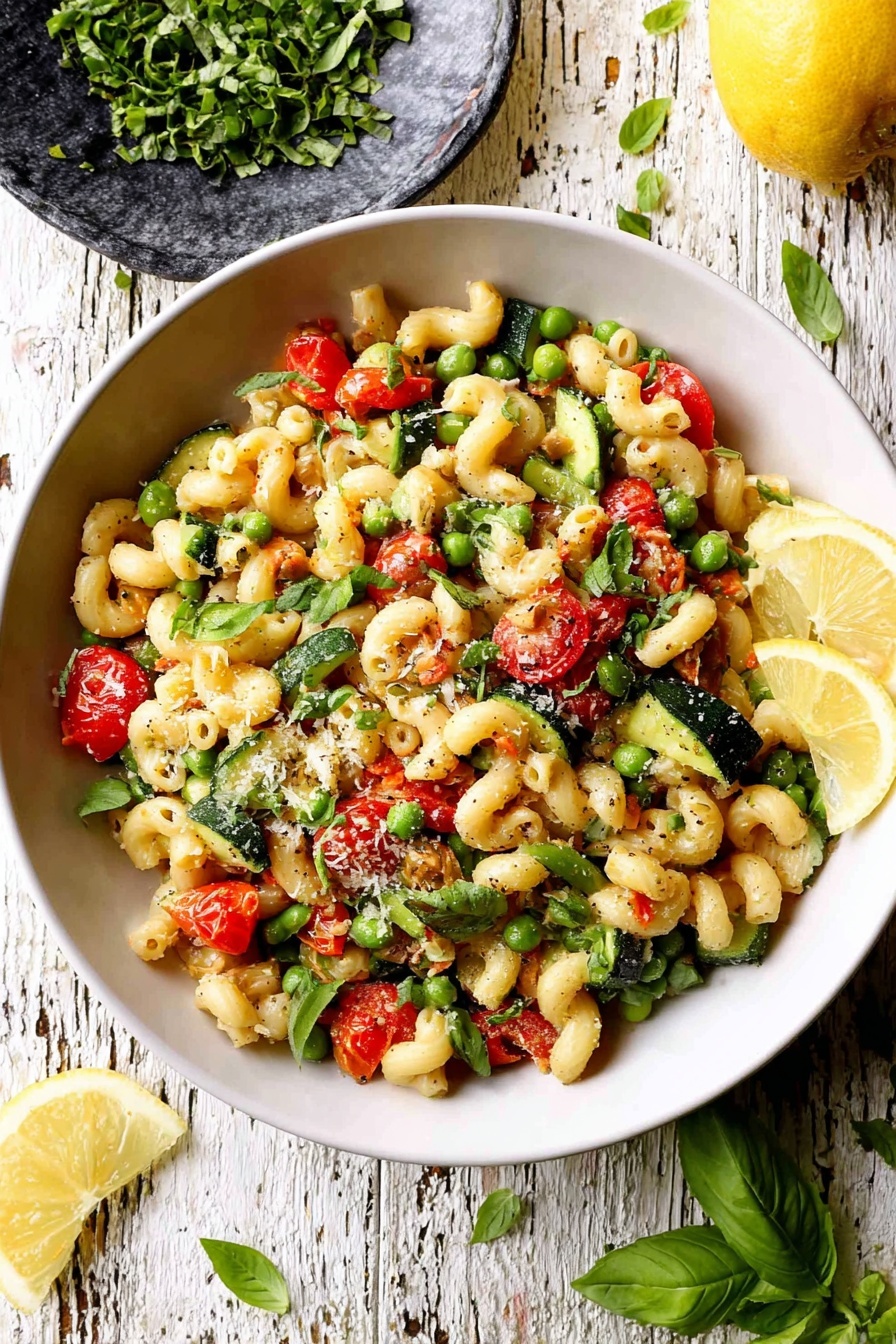
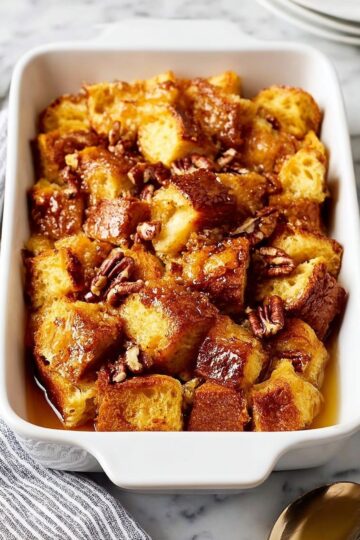

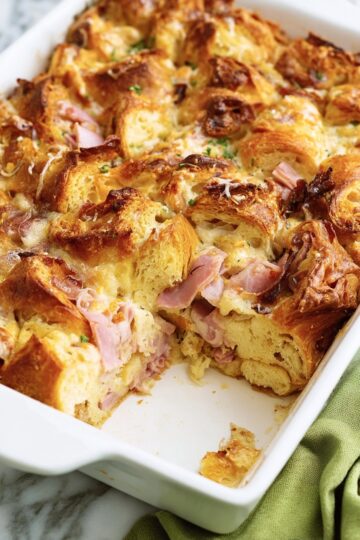

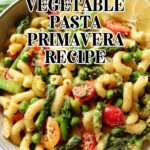
Leave a Reply